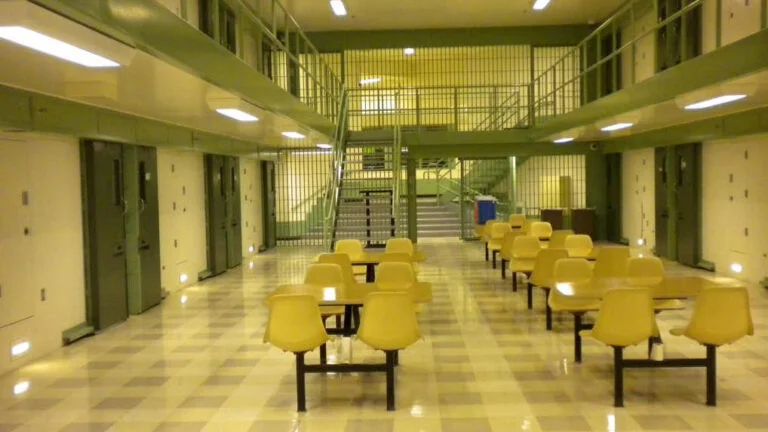The Florence Supermax prison, known as the “Alcatraz of the Rockies,” is what one former prison warden called a “clean version of hell.”
It’s a massive complex that houses the world’s most dangerous criminals. Anyone from Joaquín “El Chapo” Guzman to Ted Kaczynski can be found in this concrete cage nestled in a remote part of the Rocky Mountains.
Unlike most other prisons, where rehabilitation forms at least part of the overall purpose, in the Florence Supermax, there’s nothing of the sort. It’s all about segregation and control.
Whereas at other facilities, solitary confinement can be used as a temporary, punitive measure, here it’s a daily reality. These prisoners are locked in their 7-by-12-foot cells for 23 hours a day with just one slit-shaped window for them to glimpse the empty sky outside.
Most of these prisoners committed heinous crimes that to some would seem unforgivable. But critics argue that that still doesn’t justify the kind of cruel and unusual punishment that they’re forced to endure.
To better understand the history, origin, and controversy surrounding this “hell on earth,” let’s take a deep dive into America’s highest security prison.

Life in Florence Supermax
The silence of the halls of a supermax prison conceals the tormented existence that prisoners experience from behind the steel-mesh walls of their cells.
During a prisoner’s stay – which can last a lifetime – they have no contact with the outside world except through extremely limited means.
Each day they are allowed one hour of exercise. During this hour, they are either taken to a room with nothing but a pull-up bar, or to an outdoor cage that many have dubbed the “dog pen.”
Prisoners can also get a 15-minute phone call each month and may receive up to five visits from relatives. The visits, like everything in Florence Supermax, are tightly controlled and depend on good behavior.
Other privileges that can be earned include a black-and-white TV, books, and magazines. Beyond these limited forms of entertainment and outside communication, the prisoners have only the sounds of other prisoners echoing through the prison, or their thoughts to keep them company.
Prisoners can go for years or decades without having any kind of real human contact.
The only touch they can expect is the brief mechanical interaction of being cuffed or uncuffed, and the random strip and cavity searches that are carried out at the discretion of the guards.
This kind of extreme isolation can be brutally difficult to endure – and many inmates snap under the pressure. For anyone who has already been suffering from psychological strain, the conditions at the Florence Supermax can be devastating.
For some, suicide or self-mutilation are the only ways to cope.
But how did places like Florence Supermax come about? The answer goes back further than you might think.
The Rise of Supermax Prisons
Solitary confinement has been recognized as extremely harmful to humans as far back as the late nineteenth century.
The following quote from the United State Supreme Court in 1890 shows just how harmful this kind of punishment can be. This court found that when subjected to solitary confinement:
“‘[a] considerable number of the prisoners fell … into a semi-fatuous condition, from which it was next to impossible to arouse them, and others became violently insane, others, still, committed suicide” and even “those who stood the ordeal better . .. in most cases did not recover sufficient mental activity to be of any subsequent service to the community.’”
United States Supreme Court
Due to the destructive nature of solitary confinement, it was gradually used less and less. By the early 20th century, long-term solitary confinement was no longer part of the prison system.
Even the notorious Alcatraz, which lacked any kind of program of rehabilitation, allowed prisoners to gather for various activities throughout the day. But things changed during the second half of the 20th century.
That’s when supermax prisons started being built all across the country, revolving around the very practice that had gone out of style decades earlier.
It started in 1972 when a so-called “control unit” was built at the United States Penitentiary at Marion. Over the next two decades, 57 new supermax prisons were built, each of them designed to place prisoners in a state of complete isolation.
By 1998, 2% of the prison population in the U.S. was housed in one of these units. But the question is – why did isolation suddenly become the punishment of choice for the U.S. prison system during the 1980s and 1990s?
The Spread of Mass Incarceration and Solitary Confinement
The answer has to do with two intertwining trends – mass incarceration and an increasingly politically active prison population.
As the size of prison populations grew throughout the second half of the 20th century, prisons found themselves struggling to adequately control their prisoners.
Furthermore, the protest movements of the 1960s and 1970s created a new class of politically active prisoners who were willing to use non-violent forms of protest to demand better living conditions.
At the Marion County prison, the first prisoners to be placed in its long-term solitary confinement unit were those who participated in a work stoppage. This was organized in response to the beating of a Mexican prisoner by Marion guards.
This kind of punitive measure was deemed inappropriate by the courts. However, that didn’t spell the end of long-term solitary confinement. Just a few years later, Marion’s control unit became a permanent fixture after inmates killed two prison guards.
From then on, Marion became the country’s first permanently “locked-down” prison where all inmates were confined to their cells for 23 hours a day.
Beginning with California’s Pelican Bay prison in 1989, supermax prisons were designed from the outset to keep prisoners in a constant state of lockdown. Supermax prisons, unlike previous prisons, are built with no cafeterias, no classrooms, and no workshops.
Of all of these new maximum security structures, the Florence Supermax is the most secure. It’s the only prison that has been given a level six security designation.
But despite the increasing use of supermax prisons, some critics have voiced their alarm at the inhumane conditions that prisoners are subjected to.

The Controversy Surrounding Supermax Prisons
“I had no physical contact with another human being in at least 10 of the 18 years I was incarcerated. Today I have a hard time being around a group of people for long periods of time without feeling too crowded. . . . I will have to live with these vivid memories for the rest of my life. I would watch guys come into prison totally sane and in three years they don’t live in the real world anymore. . . . Solitary confinement does one thing, it breaks a man’s will to live and he ends up deteriorating.”
This quote was taken from the congressional testimony of a man who spent eighteen years in a supermax prison after being wrongly convicted of murder.
As he points out, the conditions in supermax prisons are extremely destructive to the people housed within their walls. Far removed from the rest of society, these inmates suffer silently in ways that can be difficult to imagine.
On the one hand, proponents of Florence Supermax argue that these systems of control are the only way to keep both the public and the rest of the prison population safe from dangerous criminals.
If you look at who’s being housed in Florence – drug lords, convicted terrorists, murderers – it’s easy to see why Florence was built the way it was.
However, what about the prisoners who don’t fit that highly violent profile?
One non-profit watchdog pointed out in 2016 that many of the prisoners housed at Florence were people suffering from mental illness. They claim that many of them were misdiagnosed when brought to prison.
This led to a cycle of abuse and punishment that often drove prisoners to suicide. Mentally ill prisoners who acted in a disruptive manner are often punished for their actions, which leads to further mental destabilization.
As a prisoner’s condition worsens, their behavior becomes more extreme, prompting more punishments and thus a further deterioration of their mental condition.
As one former inmate pointed out, there are serious consequences that come with this kind of treatment. Going beyond a physical and mental punishment:
“It can move on into degrading your soul, your spirit. And a prisoner who’s been damaged like this – from the point of view of the prison wardens – that prisoner is more controllable, more manageable.”
That’s right. If there’s one thing that’s clear about the “Alcatraz of the Rockies,” it’s that it fulfills its purpose perfectly. As a place to control and monitor dangerous criminals, Florence Supermax has no equal.
Whether there’s a better way of doing that… that’s a question that will no doubt continue to be debated for as long as these kinds of prisons exist.

